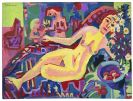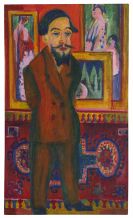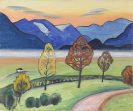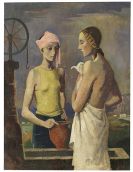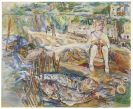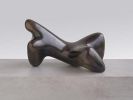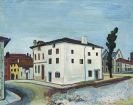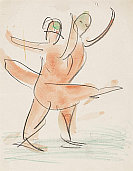
Albert Birkle
Berlin
1900 -
Salzburg
1986
Albert Birkle was born in Berlin-Charlottenburg as the first son of a family of artists. After the end of World War I he began an apprenticeship as a decorative painter in his father's business. From 1920 to 1925 he studied at the Berlin academy and was admitted to the "Berliner Sezession" as its youngest member and to the "Preußische Akademie der Künste" lead by Max Liebermann.
During his studies, Albert Birkle formed a religious and sociocritical realism with newly objective aspects, which shows features of caricature, particularly in his very individual faces.
In 1924 the artist married Elisabeth Starosta, who worked in applied arts. In 1927 the artist turned down an offer of becoming a professor at the academy in Königsberg, in order to be able to accept orders for mural paintings in churches, such as the ones in Gaislingen and Kattowitz.
In 1932 Birkle moved to Salzburg. In the 1930s Birkle's work lost its sociocritical tendencies and his landscapes and industrial motifs became more atmospheric and more monumental. In 1937 the pictures with which Birkle had represented Germany at the Venice Biennale in 1936 were removed from the "Haus der Deutschen Kunst" in Munich before the opening of an exhibition. Other pieces were also declared as "degenerate", removed from public collections and confiscated.
When World War II broke out, Albert Birkle volunteered for "Reichsarbeitsdienst", thus temporarily avoiding military service. The convinced pacifist Birkle carried out a fresco painting in the Glasenbach barracks as war painter and was sent to France as war correspondent. In 1946 Birkle received Austrian citizenship. In his newly adopted country he mainly worked as a religious glass painter, who set off on new paths using the French "Dalles technique".
In 1958 the artist was appointed professor. The years 1950 to 1960 were marked by intensive creative work in the field of glass painting. Numerous important works and window cycles with a religious and decorative tendency were created during this time. In his late expressive paintings and drawings, Albert Birkle returns to his earlier motifs from the 1920s and 1940s and their sociocritical tendencies, regarding himself a "Chronicler of time". His biblical representations also include critical comments on the time.
Albert Birkle died in Salzburg on January 29, 1986.
Would you like to sell a work by Albert Birkle?
Infos for seller
